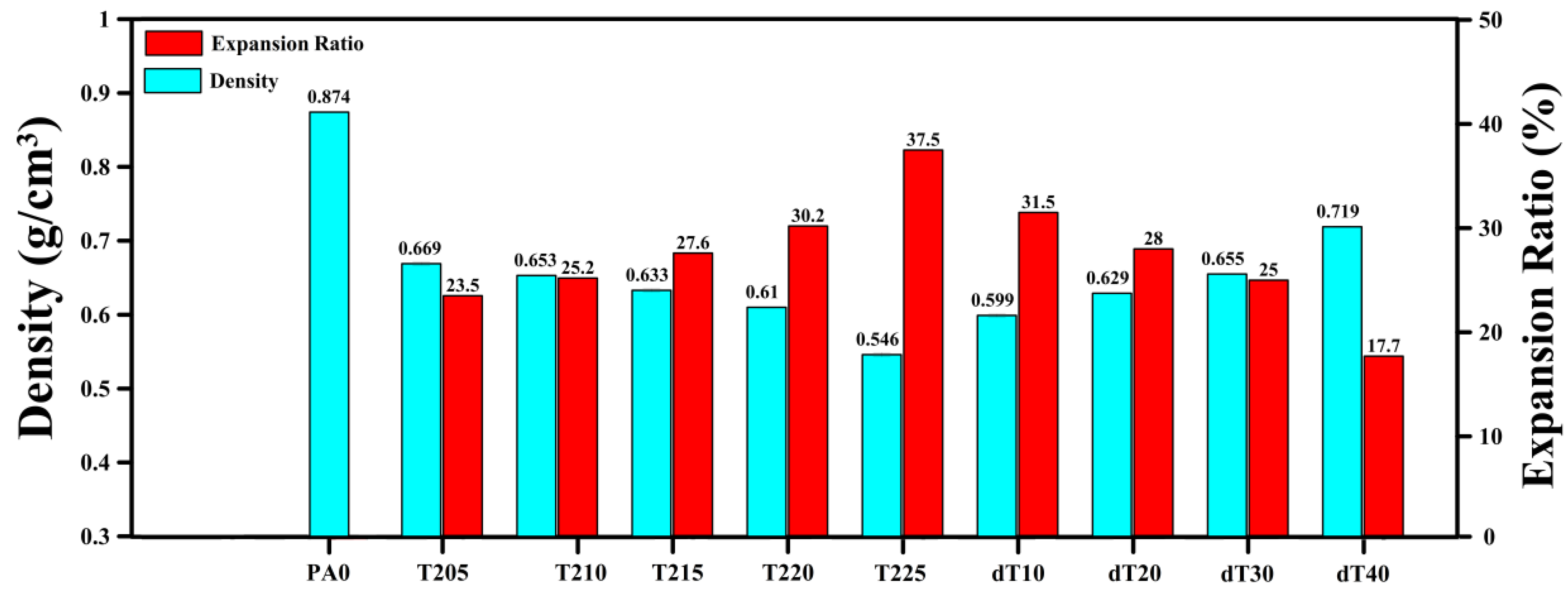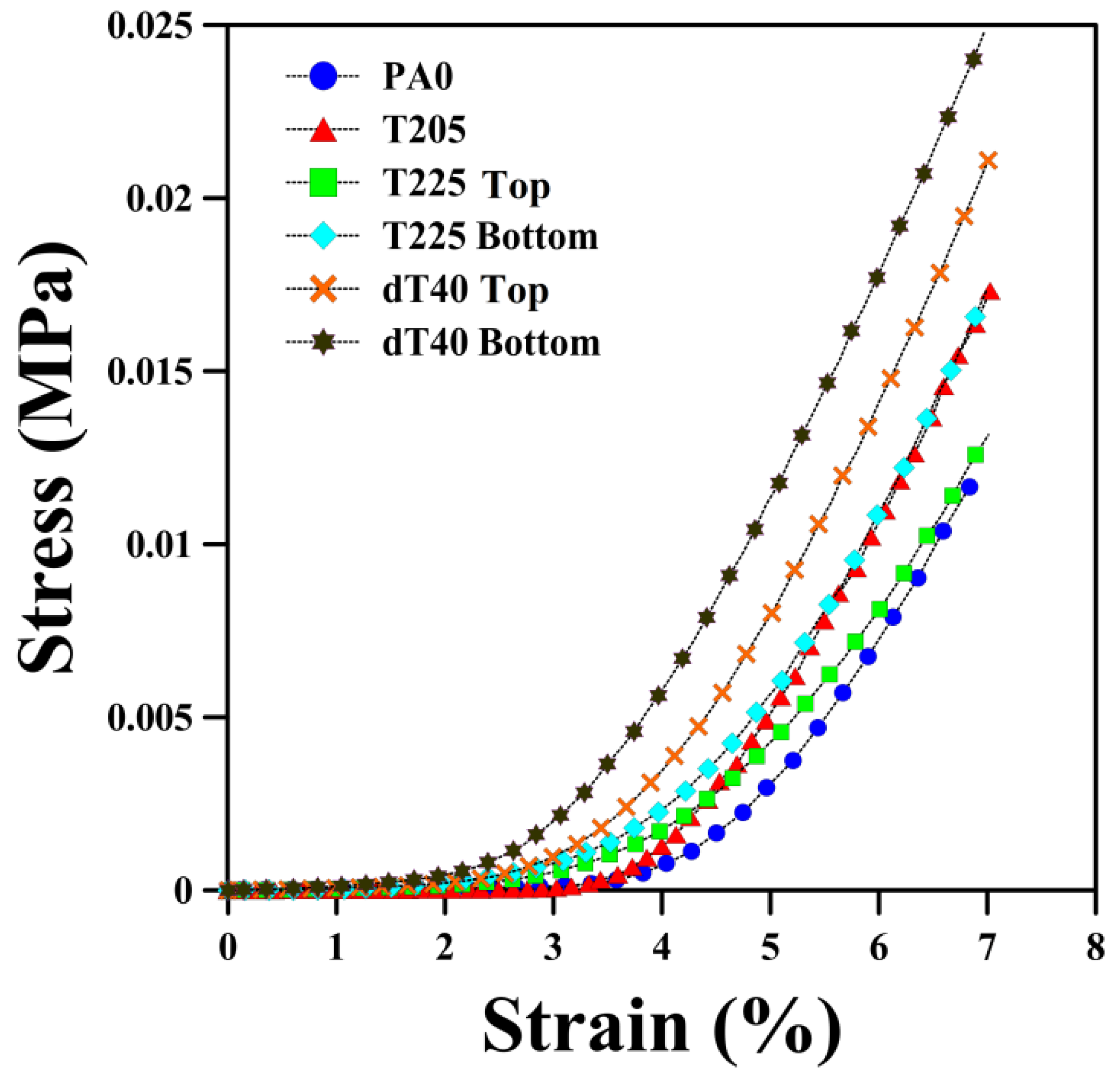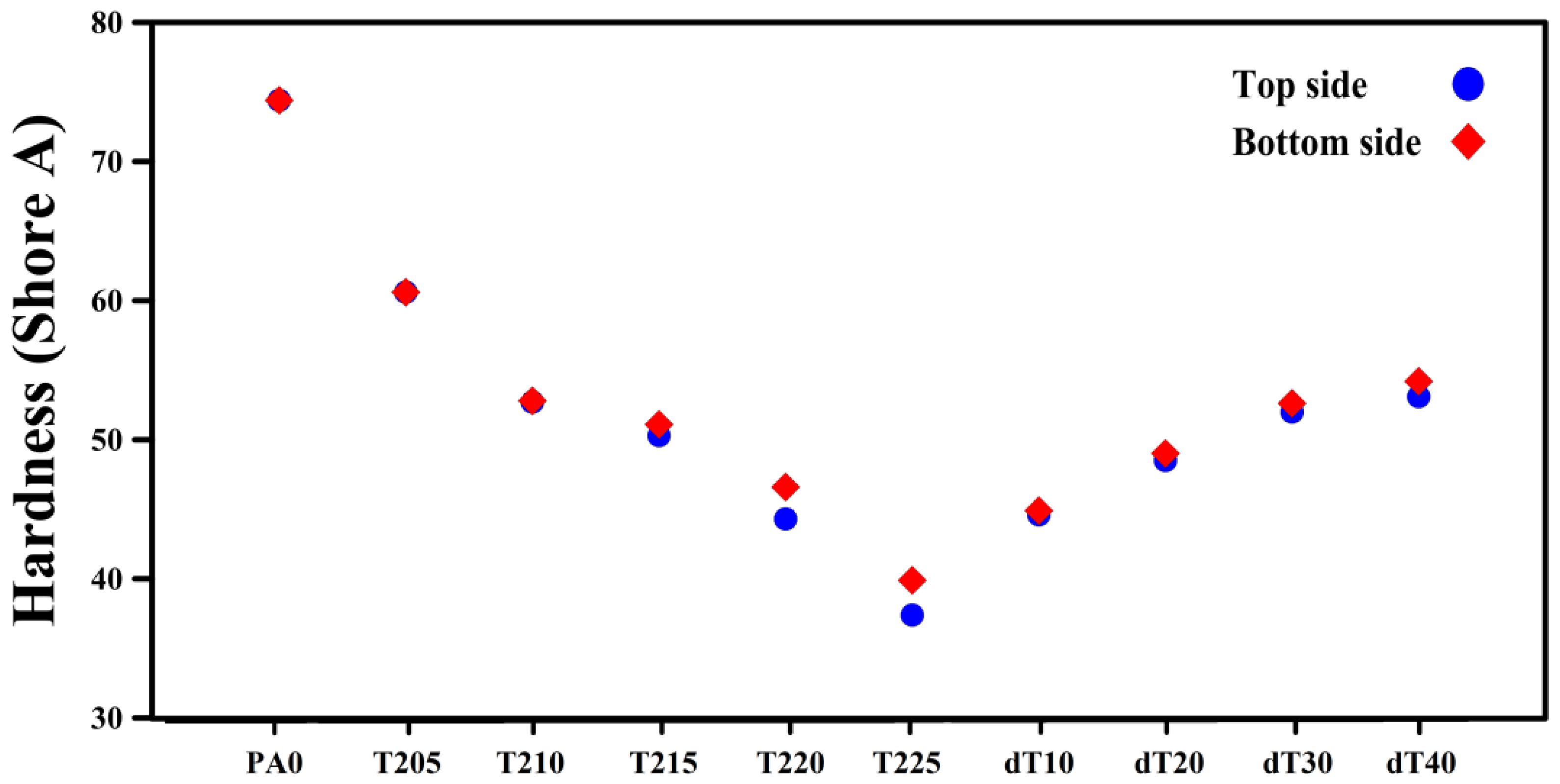Mechanical and Thermal Properties of Functionally Graded Polyolefin Elastomer Foams
Abstract
1. Introduction
2. Materials and Methods
2.1. Materials
2.2. Preparation of POE-ADC Compounds
2.3. Foam Preparation
2.4. Characterization
3. Results and Discussion
3.1. Morphological and Physical Characterization
3.1.1. First Series
3.1.2. Second Series
3.2. Mechanical Properties
3.2.1. First Series
3.2.2. Second Series
3.3. Thermal Conductivity
3.3.1. First Series
3.3.2. Second Series
4. Conclusions
Author Contributions
Funding
Institutional Review Board Statement
Informed Consent Statement
Data Availability Statement
Acknowledgments
Conflicts of Interest
References
- Vlachos, D.G.; Caratzoulas, S. The roles of catalysis and reaction engineering in overcoming the energy and the environment crisis. Chem. Eng. Sci. 2010, 65, 18–29. [Google Scholar] [CrossRef]
- Vogel, J.; Steinberger, J.K.; O’Neill, D.W.; Lamb, W.F.; Krishnakumar, J. Socio-economic conditions for satisfying human needs at low energy use: An international analysis of social provisioning. Glob. Environ. Chang. 2021, 69, 102287. [Google Scholar] [CrossRef]
- Dorotić, H.; Doračić, B.; Dobravec, V.; Pukšec, T.; Krajačić, G.; Duić, N. Integration of transport and energy sectors in island communities with 100% intermittent renewable energy sources. Renew. Sustain. Energy Rev. 2019, 99, 109–124. [Google Scholar] [CrossRef]
- Shojaie, S.; Vahidifar, A.; Naderi, G.; Shokri, E.; Mekonnen, T.H.; Esmizadeh, E. Physical Hybrid of Nanographene/Carbon Nanotubes as Reinforcing Agents of NR-Based Rubber Foam. Polymers 2021, 13, 2346. [Google Scholar] [CrossRef] [PubMed]
- Yang, C.; Zhang, Q.; Zhang, W.; Xia, M.; Yan, K.; Lu, J.; Wu, G. High thermal insulation and compressive strength polypropylene microcellular foams with honeycomb structure. Polym. Degrad. Stab. 2021, 183, 109406. [Google Scholar] [CrossRef]
- Yuan, Q.; Huang, D.; Hu, Y.; Shen, L.; Shi, L.; Zhang, M. Comparison of fire behaviors of thermally thin and thick rubber latex foam under bottom ventilation. Polymers 2019, 11, 88. [Google Scholar] [CrossRef]
- Jahani, D.; Ameli, A.; Saniei, M.; Ding, W.; Park, C.B.; Naguib, H.E. Characterization of the structure, acoustic property, thermal conductivity, and mechanical property of highly expanded open-cell polycarbonate foams. Macromol. Mater. Eng. 2015, 300, 48–56. [Google Scholar] [CrossRef]
- Vahidifar, A.; Esmizadeh, E.; Rostami, E.; Nouri-Khorasani, S.; Rodrigue, D. Morphological, rheological, and mechanical properties of hybrid elastomeric foams based on natural rubber, nanoclay, and nanocarbon black. Polym. Compos. 2019, 40, 4289–4299. [Google Scholar] [CrossRef]
- Peng, L.; Lei, L.; Liu, Y.; Du, L. Improved mechanical and sound absorption properties of open cell silicone rubber foam with NaCl as the pore-forming agent. Materials 2021, 14, 195. [Google Scholar] [CrossRef]
- Rostami-Tapeh-Esmaeil, E.; Vahidifar, A.; Esmizadeh, E.; Rodrigue, D. Chemistry, processing, properties, and applications of rubber foams. Polymers 2021, 13, 1565. [Google Scholar] [CrossRef]
- Esmizadeh, E.; Vahidifar, A.; Rostami, E.; Nouri-Khorasani, S.; Ghayoumi, M.; Khonakdar, H.A. Effect of carbon black on morphological and mechanical properties of rubber foams produced by a single-step method. J. Appl. Res. Chem. Polym. Eng. 2017, 1, 49–60. [Google Scholar]
- Pang, Y.; Cao, Y.; Zheng, W.; Park, C.B. A comprehensive review of cell structure variation and general rules for polymer microcellular foams. Chem. Eng. J. 2022, 430, 132662. [Google Scholar] [CrossRef]
- Dileep, B.; Doddamani, M. Compressive response of 3D printed graded foams. Compos. Part C 2021, 6, 100181. [Google Scholar] [CrossRef]
- Zhang, H.; Fan, X.; Chen, W.; Wang, Y.; Liu, C.; Cui, B.; Li, G.; Song, J.; Zhao, D.; Wang, D. A simple and green strategy for preparing flexible thermoplastic polyimide foams with exceptional mechanical, thermal-insulating properties, and temperature resistance for high-temperature lightweight composite sandwich structures. Compos. Part B Eng. 2022, 228, 109405. [Google Scholar] [CrossRef]
- Xie, Z.; Cai, Y.; Zhan, Y.; Meng, Y.; Li, Y.; Xie, Q.; Xia, H. Thermal insulating rubber foams embedded with segregated carbon nanotube networks for electromagnetic shielding applications. Chem. Eng. J. 2022, 435, 135118. [Google Scholar] [CrossRef]
- Olszewski, A.; Kosmela, P.; Żukowska, W.; Wojtasz, P.; Szczepański, M.; Barczewski, M.; Zedler, Ł.; Formela, K.; Hejna, A. Insights into Stoichiometry Adjustments Governing the performance of flexible foamed polyurethane/ground tire rubber composites. Polymers 2022, 14, 3838. [Google Scholar] [CrossRef]
- Placido, E.; Arduini-Schuster, M.; Kuhn, J. Thermal properties predictive model for insulating foams. Infrared Phys. Technol. 2005, 46, 219–231. [Google Scholar] [CrossRef]
- Huang, C.; Qian, X.; Yang, R. Thermal conductivity of polymers and polymer nanocomposites. Mater. Sci. Eng. R Rep. 2018, 132, 1–22. [Google Scholar] [CrossRef]
- O’Connor, K.S.; Watts, A.; Vaidya, T.; LaPointe, A.M.; Hillmyer, M.A.; Coates, G.W. Controlled chain walking for the synthesis of thermoplastic polyolefin elastomers: Synthesis, structure, and properties. Macromolecules 2016, 49, 6743–6751. [Google Scholar] [CrossRef]
- Huang, Y.; Xiao, X.; Kang, H.; Lv, J.; Zeng, R.; Shen, J. Thermal management of polymer electrolyte membrane fuel cells: A critical review of heat transfer mechanisms, cooling approaches, and advanced cooling techniques analysis. Energy Convers. Manag. 2022, 254, 115221. [Google Scholar] [CrossRef]
- Yao, J.; Rodrigue, D. Density graded polyethylene foams produced by compression molding using a chemical blowing agent. Cell. Polym. 2012, 31, 189–206. [Google Scholar] [CrossRef]
- Suethao, S.; Shah, D.U.; Smitthipong, W. Recent progress in processing functionally graded polymer foams. Materials 2020, 13, 4060. [Google Scholar] [CrossRef] [PubMed]
- Duan, Y.; Ding, Y.; Liu, Z.; Hou, N.; Zhao, X.; Liu, H.; Zhao, Z.; Hou, B.; Li, Y. Effects of cell size vs. cell-wall thickness gradients on compressive behavior of additively manufactured foams. Compos. Sci. Technol. 2020, 199, 108339. [Google Scholar] [CrossRef]
- Mannella, G.; Conoscenti, G.; Pavia, F.C.; La Carrubba, V.; Brucato, V. Preparation of polymeric foams with a pore size gradient via Thermally Induced Phase Separation (TIPS). Mater. Lett. 2015, 160, 31–33. [Google Scholar] [CrossRef]
- Trofa, M.; Di Maio, E.; Maffettone, P.L. Multi-graded foams upon time-dependent exposition to blowing agent. Chem. Eng. J. 2019, 362, 812–817. [Google Scholar] [CrossRef]
- Rahman, O.; Uddin, K.Z.; Muthulingam, J.; Youssef, G.; Shen, C.; Koohbor, B. Density-Graded Cellular Solids: Mechanics, Fabrication, and Applications. Adv. Eng. Mater. 2022, 24, 2100646. [Google Scholar] [CrossRef]
- Yao, J.; Barzegari, M.R.; Rodrigue, D. Density graded linear medium density polyethylene foams produced under a temperature gradient with Expancel microbeads. Cell. Polym. 2011, 30, 157–186. [Google Scholar] [CrossRef]
- Mirabolghasemi, A.; Akbarzadeh, A.; Rodrigue, D.; Therriault, D. Thermal conductivity of architected cellular metamaterials. Acta Mater. 2019, 174, 61–80. [Google Scholar] [CrossRef]
- Niknam, H.; Akbarzadeh, A.; Rodrigue, D.; Therriault, D. Architected multi-directional functionally graded cellular plates. Mater. Des. 2018, 148, 188–202. [Google Scholar] [CrossRef]
- Barzegari, M.R.; Yao, J.; Rodrigue, D. Mechanical properties of density graded foams: Tensile properties. Cell. Polym. 2013, 32, 323–342. [Google Scholar] [CrossRef]
- Barzegari, M.R.; Yao, J.; Rodrigue, D. Compression molding of polyethylene foams under a temperature gradient: Morphology and flexural modulus. Cell. Polym. 2009, 28, 237–248. [Google Scholar] [CrossRef]
- Kiernan, S.; Cui, L.; Gilchrist, M.D. Propagation of a stress wave through a virtual functionally graded foam. Int. J. Non-Linear Mech. 2009, 44, 456–468. [Google Scholar] [CrossRef]
- Yang, J.; Wang, S.; Ding, Y.; Zheng, Z.; Yu, J. Crashworthiness of graded cellular materials: A design strategy based on a nonlinear plastic shock model. Mater. Sci. Eng. A 2017, 680, 411–420. [Google Scholar] [CrossRef]
- Stubenrauch, C.; Menner, A.; Bismarck, A.; Drenckhan, W. Emulsion and foam templating—Promising routes to tailor-made porous polymers. Angew. Chem. Int. Ed. 2018, 57, 10024–10032. [Google Scholar] [CrossRef]
- Gupta, N. A functionally graded syntactic foam material for high energy absorption under compression. Mater. Lett. 2007, 61, 979–982. [Google Scholar] [CrossRef]
- Zhou, C.; Wang, P.; Li, W. Fabrication of functionally graded porous polymer via supercritical CO2 foaming. Compos. Part B Eng. 2011, 42, 318–325. [Google Scholar] [CrossRef]
- Ghaffari-Mosanenzadeh, S.; Naguib, H.E.; Park, C.B.; Atalla, N. Design and development of novel bio-based functionally graded foams for enhanced acoustic capabilities. J. Mater. Sci. 2015, 50, 1248–1256. [Google Scholar] [CrossRef]
- Rostami-Tapeh-Esmaeil, E.; Heydari, A.; Esmizadeh, E.; Vahidifar, A.; Rodrigue, D. Experimental and Finite Element Simulation of Polyolefin Elastomer Foams Using Real 3D Structures: Effect of Foaming Agent Content. J. Elastomers Plast. 2022; submitted. [Google Scholar]
- Zauzi, N.A.; Ariff, Z.; Khimi, S. Foamability of natural rubber via microwave assisted foaming with azodicarbonamide (ADC) as blowing agent. Mater. Today Proc. 2019, 17, 1001–1007. [Google Scholar] [CrossRef]
- Rostami-Tapeh-Esmail, E.; Golshan, M.; Salami-Kalajahi, M.; Roghani-Mamaqani, H. UV-stabilized self-assembled amphiphilic triblock terpolymers supramolecular structures with low cytotoxicity as doxorubicin carriers. Mater. Sci. Eng. C 2020, 110, 110745. [Google Scholar] [CrossRef]
- Rostami-Tapeh-Esmail, E.; Golshan, M.; Salami-Kalajahi, M.; Roghani-Mamaqani, H.; Kahaie-Khosrowshahi, A. Temperature-induced self-assembly of amphiphilic triblock terpolymers to low cytotoxic spherical and cubic structures as curcumin carriers. J. Mol. Liq. 2020, 313, 113504. [Google Scholar] [CrossRef]
- Rostami-Tapeh-Esmaeil, E.; Golshan, M.; Salami-Kalajahi, M.; Roghani-Mamaqani, H. Synthesis of copper and copper oxide nanoparticles with different morphologies using aniline as reducing agent. Solid State Commun. 2021, 334, 114364. [Google Scholar] [CrossRef]
- Kabamba, E.T.; Rodrigue, D. The effect of recycling on LDPE foam properties. Prog. Rubber Plast. Recycl. Technol. 2008, 24, 1–17. [Google Scholar] [CrossRef]
- Bhattacharya, S.; Gupta, R.K.; Jollands, M.; Bhattacharya, S.N. Foaming behavior of high-melt strength polypropylene/clay nanocomposites. Polym. Eng. Sci. 2009, 49, 2070–2084. [Google Scholar] [CrossRef]
- Nofar, M.; Park, C.B. Poly (lactic acid) foaming. Prog. Polym. Sci. 2014, 39, 1721–1741. [Google Scholar] [CrossRef]
- Mohebbi, A.; Mighri, F.; Ajji, A.; Rodrigue, D. Current issues and challenges in polypropylene foaming: A review. Cell. Polym. 2015, 34, 299–338. [Google Scholar] [CrossRef]
- Ge, Y.; Lu, J.; Liu, T. Analysis of bubble coalescence and determination of the bubble radius for long-chain branched poly (ethylene terephthalate) melt foaming with a pressure balanced bubble-growth model. AIChE J. 2020, 66, e16862. [Google Scholar] [CrossRef]
- Li, S.; Li, Q. Response of functionally graded polymeric foam under axial compression. Int. J. Mech. Sci. 2021, 210, 106750. [Google Scholar] [CrossRef]
- Luong, D.D.; Pinisetty, D.; Gupta, N. Compressive properties of closed-cell polyvinyl chloride foams at low and high strain rates: Experimental investigation and critical review of state of the art. Compos. Part B Eng. 2013, 44, 403–416. [Google Scholar] [CrossRef]
- Wang, G.; Liu, J.; Zhao, J.; Li, S.; Zhao, G.; Park, C.B. Structure-gradient thermoplastic polyurethane foams with enhanced resilience derived by microcellular foaming. J. Supercrit. Fluids 2022, 188, 105667. [Google Scholar] [CrossRef]
- Gama, N.V.; Soares, B.; Freire, C.S.; Silva, R.; Neto, C.P.; Barros-Timmons, A.; Ferreira, A. Bio-based polyurethane foams toward applications beyond thermal insulation. Mater. Des. 2015, 76, 77–85. [Google Scholar] [CrossRef]
- Ferkl, P.; Pokorný, R.; Bobák, M.; Kosek, J. Heat transfer in one-dimensional micro-and nano-cellular foams. Chem. Eng. Sci. 2013, 97, 50–58. [Google Scholar] [CrossRef]





| Sample Code | T1 (°C) | T2 (°C) | ΔT = T2 − T1 (°C) | Tavg (°C) |
|---|---|---|---|---|
| T205 | 205 | 205 | 0 | 205 |
| T210 | 205 | 210 | 5 | 207.5 |
| T215 | 205 | 215 | 10 | 210 |
| T220 | 205 | 220 | 15 | 212.5 |
| T225 | 205 | 225 | 20 | 215 |
| dT10 | 200 | 210 | 10 | 205 |
| dT20 | 195 | 215 | 20 | 205 |
| dT30 | 190 | 220 | 30 | 205 |
| dT40 | 185 | 225 | 40 | 205 |
| Sample | Dn (µm) | Dw (µm) | PDI (-) | Cell Density (cells/mm3) | ||||
| Top | Bottom | Top | Bottom | Top | Bottom | Top | Bottom | |
| T205 | 105 | 105 | 107 | 107 | 1.022 | 1.022 | 570 | 570 |
| T210 | 117 | 107 | 119 | 108 | 1.018 | 1.012 | 750 | 820 |
| T215 | 137 | 102 | 138 | 104 | 1.006 | 1.013 | 440 | 550 |
| T220 | 149 | 102 | 151 | 104 | 1.009 | 1.020 | 260 | 640 |
| T225 | 154 | 104 | 157 | 105 | 1.016 | 1.010 | 330 | 800 |
| Sample | Dn (µm) | Dw (µm) | PDI (-) | Cell density (cells/mm3) | ||||
| Middle | Top and Bottom | Middle | Top and Bottom | Middle | Top and Bottom | Middle | Top and Bottom | |
| dT10 | 98.0 | 122 | 99.7 | 126 | 1.018 | 1.030 | 680 | 430 |
| dT20 | 128 | 139 | 131 | 144 | 1.022 | 1.035 | 320 | 290 |
| dT30 | 166 | 286 | 169 | 292 | 1.017 | 1.022 | 380 | 204 |
| dT40 | 176 | 337 | 179 | 342 | 1.016 | 1.015 | 360 | 205 |
| Sample | Tensile Properties | Hardness | ||||
|---|---|---|---|---|---|---|
| Modulus @ 100% (MPa) | Strength @ Break (MPa) | Elongation @ Break (%) | (Shore A) | |||
| Top | Bottom | Average | ||||
| PA0 | 1.11 ± 0.01 | 6.48 ± 0.91 | 1290 ± 98 | 74.4 ± 0.3 | 74.4 ± 0.3 | 74.4 |
| T205 | 0.70 ± 0.03 | 2.55 ± 0.29 | 939 ± 43 | 60.6 ± 0.3 | 60.6 ± 0.3 | 60.6 |
| T210 | 0.66 ± 0.01 | 2.49 ± 0.10 | 881 ± 10 | 52.7 ± 0.5 | 52.8 ± 0.4 | 52.8 |
| T215 | 0.58 ± 0.02 | 2.35 ± 0.10 | 846 ± 10 | 50.3 ± 0.5 | 51.1 ± 0.6 | 50.7 |
| T220 | 0.55 ± 0.02 | 2.20 ± 0.01 | 782 ± 16 | 44.3 ± 0.5 | 46.6 ± 0.4 | 45.5 |
| T225 | 0.44 ± 0.01 | 2.18 ± 0.10 | 746 ± 28 | 37.4 ± 0.5 | 39.9 ± 0.4 | 38.7 |
| dT10 | 0.57 ± 0.03 | 2.21 ± 0.10 | 906 ± 7 | 44.6 ± 0.5 | 44.9 ± 0.4 | 44.8 |
| dT20 | 0.61 ± 0.03 | 2.25 ± 0.07 | 941 ± 11 | 48.5 ± 0.3 | 49.0 ± 0.4 | 48.8 |
| dT30 | 0.63 ± 0.05 | 2.66 ± 0.08 | 972 ± 8 | 52.0 ± 0.6 | 52.6 ± 0.5 | 52.3 |
| dT40 | 0.65 ± 0.09 | 2.78 ± 0.04 | 992 ± 9 | 53.1 ± 0.7 | 54.2 ± 0.7 | 53.7 |
| Sample | k (W/m.K) | ||
|---|---|---|---|
| Top | Bottom | Average | |
| PA0 | 0.193 ± 0.001 | 0.193 ± 0.001 | 0.193 |
| T205 | 0.165 ± 0.002 | 0.165 ± 0.002 | 0.165 |
| T210 | 0.162 ± 0.004 | 0.160 ± 0.006 | 0.161 |
| T215 | 0.158 ± 0.001 | 0.154 ± 0.003 | 0.156 |
| T220 | 0.143 ± 0.002 | 0.137 ± 0.002 | 0.140 |
| T225 | 0.128 ± 0.001 | 0.121 ± 0.002 | 0.125 |
| dT10 | 0.169 ± 0.005 | 0.168 ± 0.001 | 0.169 |
| dT20 | 0.172 ± 0.002 | 0.170 ± 0.003 | 0.171 |
| dT30 | 0.176 ± 0.001 | 0.174 ± 0.002 | 0.175 |
| dT40 | 0.181 ± 0.001 | 0.178 ± 0.002 | 0.180 |
Publisher’s Note: MDPI stays neutral with regard to jurisdictional claims in published maps and institutional affiliations. |
© 2022 by the authors. Licensee MDPI, Basel, Switzerland. This article is an open access article distributed under the terms and conditions of the Creative Commons Attribution (CC BY) license (https://creativecommons.org/licenses/by/4.0/).
Share and Cite
Rostami-Tapeh-Esmaeil, E.; Shojaei, S.; Rodrigue, D. Mechanical and Thermal Properties of Functionally Graded Polyolefin Elastomer Foams. Polymers 2022, 14, 4124. https://doi.org/10.3390/polym14194124
Rostami-Tapeh-Esmaeil E, Shojaei S, Rodrigue D. Mechanical and Thermal Properties of Functionally Graded Polyolefin Elastomer Foams. Polymers. 2022; 14(19):4124. https://doi.org/10.3390/polym14194124
Chicago/Turabian StyleRostami-Tapeh-Esmaeil, Ehsan, Sahar Shojaei, and Denis Rodrigue. 2022. "Mechanical and Thermal Properties of Functionally Graded Polyolefin Elastomer Foams" Polymers 14, no. 19: 4124. https://doi.org/10.3390/polym14194124
APA StyleRostami-Tapeh-Esmaeil, E., Shojaei, S., & Rodrigue, D. (2022). Mechanical and Thermal Properties of Functionally Graded Polyolefin Elastomer Foams. Polymers, 14(19), 4124. https://doi.org/10.3390/polym14194124








